Weather conditions play a crucial role in determining the durability and longevity of outdoor furniture, as they can lead to material degradation and compromise structural integrity. Factors such as UV exposure, moisture, and temperature fluctuations can significantly affect the lifespan of your furniture, making it essential to choose the right materials and implement protective measures.
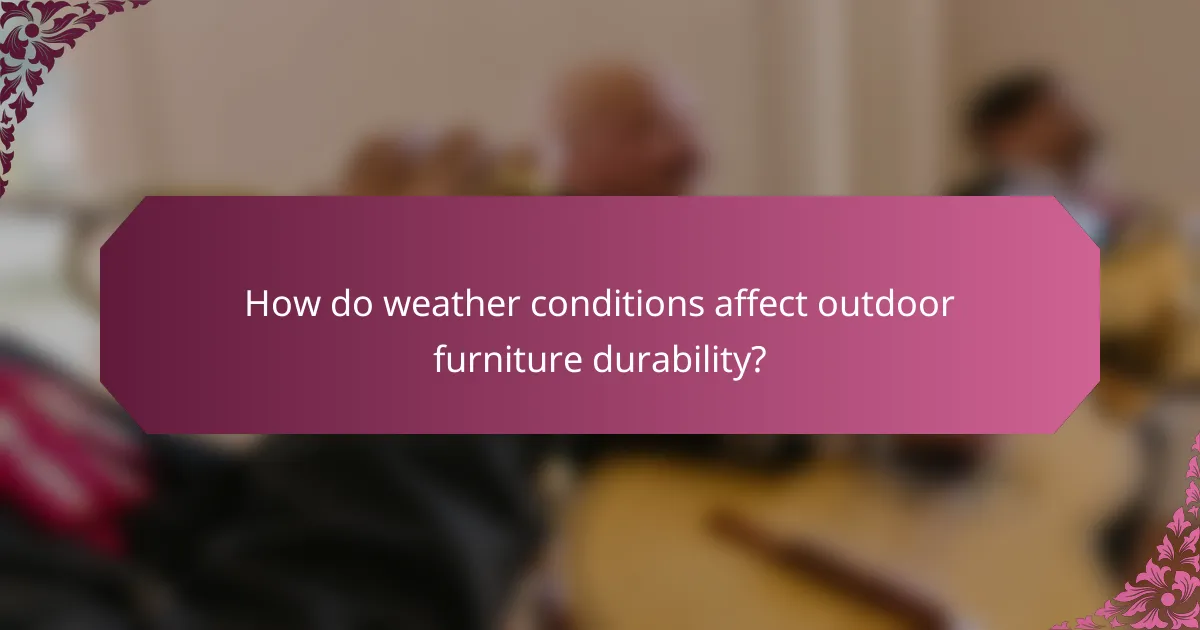
How do weather conditions affect outdoor furniture durability?
Weather conditions significantly impact the durability of outdoor furniture by influencing material degradation and structural integrity. Factors such as UV exposure, moisture levels, and temperature changes can shorten the lifespan of furniture if not properly managed.
Impact of UV exposure on materials
UV exposure can lead to fading, discoloration, and brittleness in outdoor furniture materials. For instance, plastics may become chalky, while wood can warp or crack if not treated with UV-resistant finishes.
To mitigate UV damage, consider using covers or storing furniture indoors during peak sunlight hours. Choosing materials like teak or synthetic wicker, which are more resistant to UV rays, can also enhance longevity.
Effects of moisture and humidity
Moisture and humidity can cause wood to swell, rot, or develop mold, while metal furniture may experience rust. High humidity levels can exacerbate these issues, especially in coastal areas where saltwater is present.
To protect against moisture, apply water-resistant sealants to wooden furniture and ensure metal pieces are coated with rust-resistant paint. Regular cleaning and drying after rain can also help maintain the integrity of outdoor furniture.
Temperature fluctuations and material integrity
Temperature fluctuations can cause materials to expand and contract, leading to cracks or structural failure. For example, extreme cold can make plastics brittle, while excessive heat can warp wood.
To minimize damage from temperature changes, select materials designed for outdoor use, such as aluminum or high-density polyethylene. Additionally, avoid placing furniture in direct contact with heat sources, like fire pits, to preserve its structural integrity.

What materials are best for outdoor furniture in varying climates?
The best materials for outdoor furniture depend on the climate in which they will be used. Selecting the right material can significantly enhance durability and longevity, ensuring your furniture withstands environmental challenges.
Teak wood for humid environments
Teak wood is an excellent choice for humid climates due to its natural oils that resist moisture and prevent warping. This hardwood can endure heavy rainfall and high humidity without deteriorating, making it ideal for areas with significant rainfall.
When choosing teak, look for sustainably sourced options to ensure environmental responsibility. Regular maintenance, such as oiling, can help maintain its rich color and extend its lifespan.
Aluminum for coastal areas
Aluminum is highly recommended for coastal regions because it is lightweight, rust-resistant, and can withstand salty air. This material does not corrode easily, making it suitable for environments where moisture and salt are prevalent.
Consider powder-coated aluminum for added durability and color retention. It requires minimal maintenance, making it a practical choice for outdoor settings near the ocean.
Resin wicker for UV resistance
Resin wicker is ideal for sunny climates due to its UV-resistant properties, which prevent fading and cracking. This synthetic material mimics traditional wicker but offers enhanced durability against sun exposure.
When selecting resin wicker, ensure it is high-density polyethylene (HDPE) for superior strength and weather resistance. Regular cleaning with mild soap and water will help maintain its appearance and longevity.
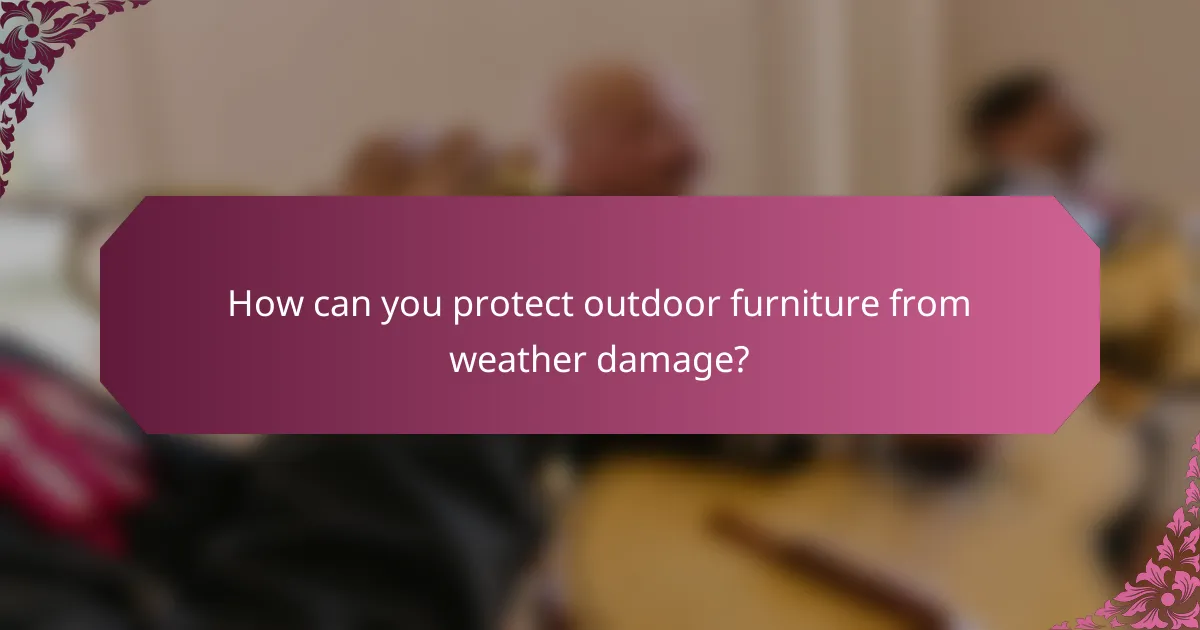
How can you protect outdoor furniture from weather damage?
To protect outdoor furniture from weather damage, use a combination of protective covers, regular maintenance, and seasonal storage solutions. These strategies help extend the lifespan of your furniture by minimizing exposure to harsh elements.
Use of protective covers
Protective covers are essential for shielding outdoor furniture from rain, snow, and UV rays. Choose covers made from breathable, water-resistant materials to prevent moisture buildup while keeping dirt and debris at bay.
When selecting covers, ensure they fit snugly to avoid wind displacement. Look for features like straps or ties to secure them in place, especially in windy conditions.
Regular maintenance and cleaning
Regular maintenance and cleaning are crucial for preserving the appearance and durability of outdoor furniture. Clean surfaces with mild soap and water to remove dirt and grime, and avoid harsh chemicals that can damage finishes.
Inspect furniture periodically for signs of wear, such as rust on metal pieces or fading on wood. Applying protective sealants or finishes can enhance durability, particularly for wooden furniture exposed to moisture.
Seasonal storage solutions
Seasonal storage solutions can significantly reduce weather-related wear and tear. During harsh winter months or extreme weather, consider storing furniture indoors or in a sheltered area to protect it from the elements.
If indoor storage isn’t possible, use a well-ventilated shed or garage. Elevate furniture off the ground using pallets to prevent moisture absorption and consider using desiccants to control humidity levels in storage spaces.
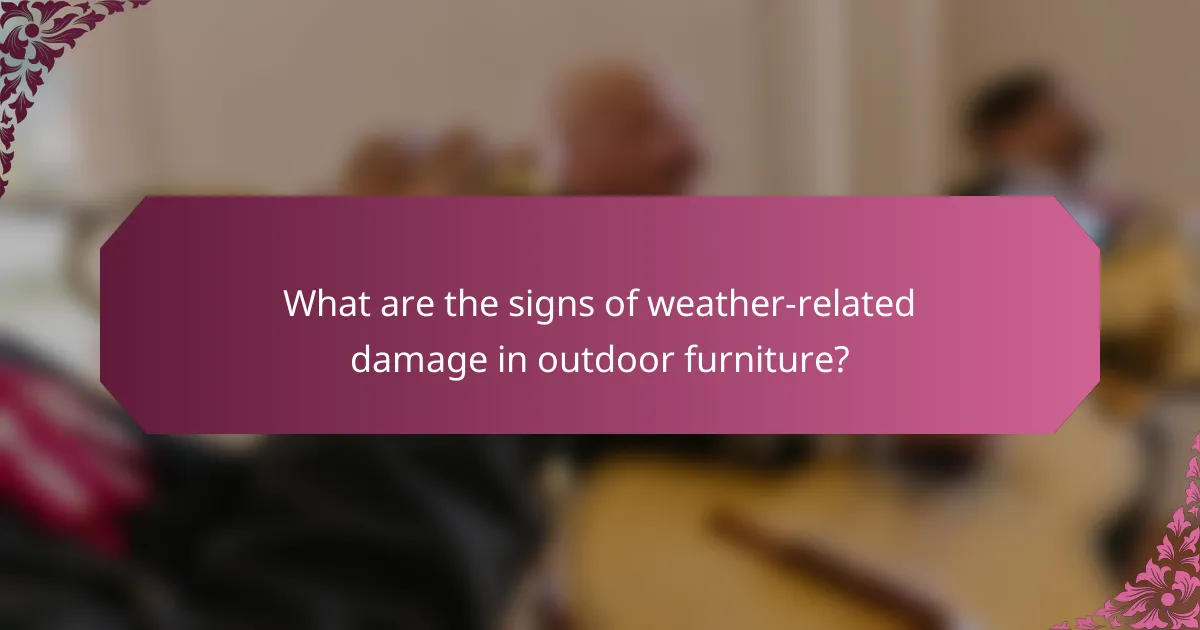
What are the signs of weather-related damage in outdoor furniture?
Signs of weather-related damage in outdoor furniture include visible changes such as fading, cracking, and rusting. These indicators reveal how exposure to elements like sun, rain, and humidity can compromise the integrity and appearance of outdoor furnishings.
Fading and discoloration
Fading and discoloration occur when outdoor furniture is repeatedly exposed to sunlight. UV rays can break down the pigments in materials, leading to a washed-out appearance over time.
To mitigate fading, consider using UV-resistant coatings or covers when the furniture is not in use. Regularly applying protective treatments can help maintain color vibrancy and extend the life of the furniture.
Cracking and splitting
Cracking and splitting are common in wooden and plastic outdoor furniture due to temperature fluctuations and moisture exposure. These conditions can cause materials to expand and contract, leading to structural damage.
To prevent cracking, choose furniture made from durable, weather-resistant materials. Regularly inspect for signs of wear and apply sealants or protective oils to wooden pieces to maintain their integrity.
Rust and corrosion
Rust and corrosion primarily affect metal outdoor furniture, especially those made from iron or steel. Moisture and oxygen can lead to oxidation, resulting in unsightly rust spots and weakened structures.
To combat rust, opt for furniture with protective coatings, such as powder coating or galvanization. Regular cleaning and prompt removal of moisture can also help prevent corrosion and prolong the life of metal furnishings.
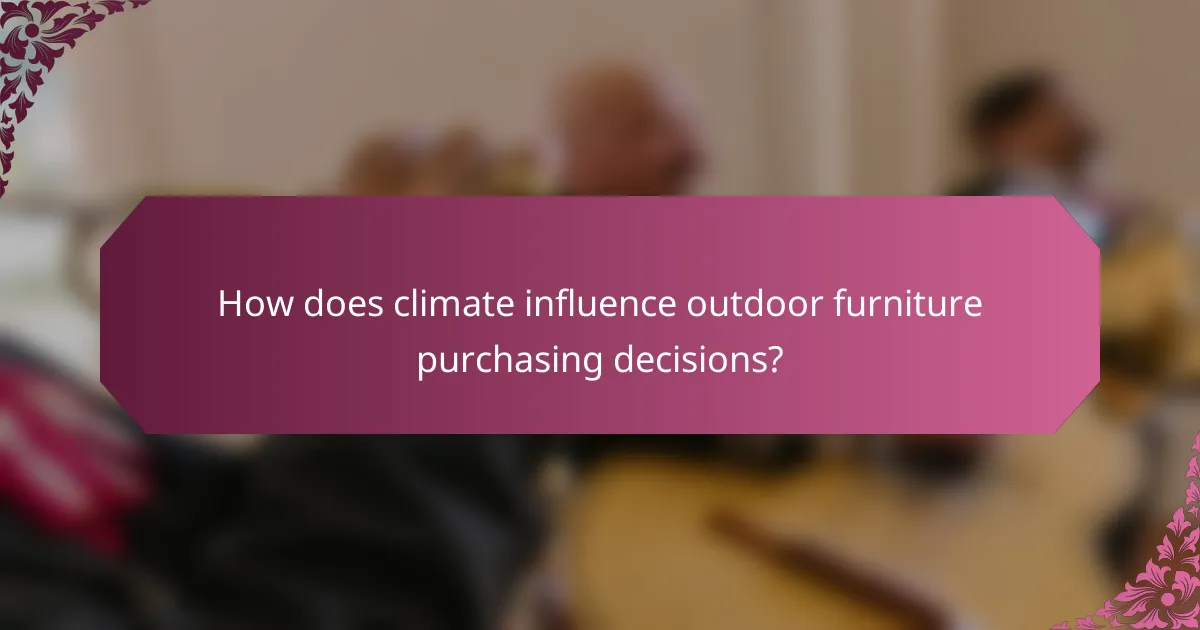
How does climate influence outdoor furniture purchasing decisions?
Climate significantly affects outdoor furniture purchasing decisions by determining the durability and longevity of materials. Buyers often prioritize weather-resistant options to ensure their investments withstand local environmental conditions.
Choosing weather-resistant materials
Selecting weather-resistant materials is crucial for outdoor furniture longevity. Common options include teak, eucalyptus, aluminum, and synthetic wicker, which can endure various weather conditions without deteriorating. For instance, teak naturally resists moisture and insects, making it ideal for humid climates.
When choosing materials, consider the trade-offs between aesthetics and durability. While wood offers a classic look, metals like aluminum provide lightweight and rust-resistant alternatives. Always check for UV protection and water resistance ratings to ensure optimal performance.
Considering local climate patterns
Understanding local climate patterns helps in selecting the right outdoor furniture. For example, areas with high humidity may require materials that resist mold and mildew, while regions with intense sun exposure benefit from UV-resistant finishes. Researching average temperatures and precipitation levels can guide your choices.
Additionally, consider seasonal changes. If your area experiences harsh winters, opt for furniture that can be easily stored or covered. Investing in protective covers can extend the life of your furniture, regardless of material, by shielding it from rain, snow, and sun damage.
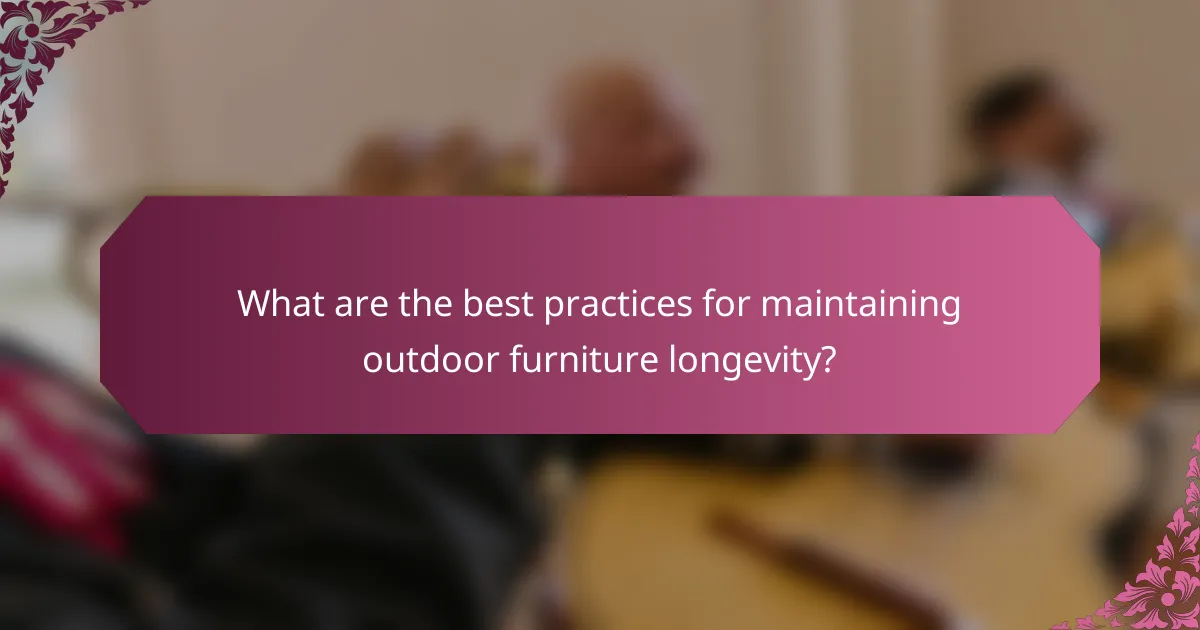
What are the best practices for maintaining outdoor furniture longevity?
To ensure the longevity of outdoor furniture, regular maintenance and care are essential. This includes performing inspections, cleaning, and making necessary repairs to withstand various weather conditions.
Regular inspections and repairs
Conducting regular inspections of outdoor furniture helps identify wear and tear early. Look for signs of rust, rot, or loose joints, and address these issues promptly to prevent further damage.
Repairing minor damages, such as tightening screws or applying protective coatings, can significantly extend the life of your furniture. For wooden pieces, consider re-staining or sealing every few years to protect against moisture and UV damage.
Seasonal cleaning routines
Establishing a seasonal cleaning routine is crucial for maintaining outdoor furniture. Use a mild soap solution and a soft brush to clean surfaces, removing dirt, grime, and mildew that can degrade materials over time.
After cleaning, ensure that furniture is completely dry before covering or storing it for the season. For metal furniture, applying a protective wax can help prevent rust, while cushions should be stored in a dry place to avoid mold growth.
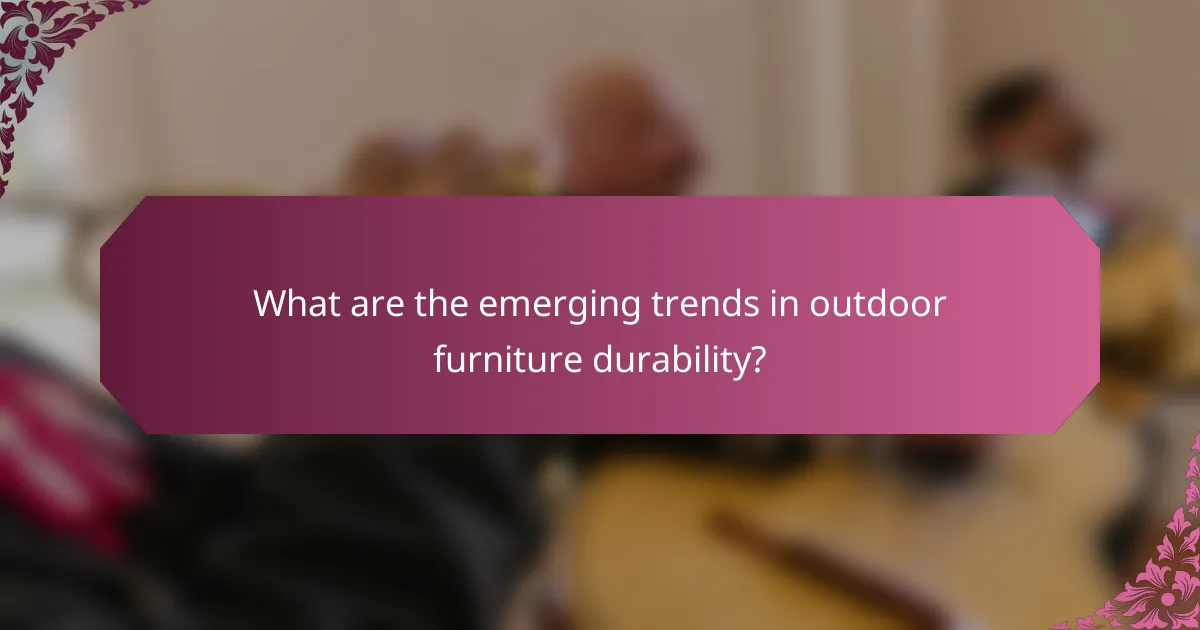
What are the emerging trends in outdoor furniture durability?
Emerging trends in outdoor furniture durability focus on enhanced materials and protective technologies that extend the lifespan of outdoor pieces. Key developments include the use of innovative coatings and sustainable materials designed to withstand various weather conditions.
Innovative weather-resistant coatings
Weather-resistant coatings are becoming essential for outdoor furniture, providing a barrier against moisture, UV rays, and temperature fluctuations. These coatings can significantly enhance the durability of materials like wood, metal, and plastic, preventing deterioration and fading over time.
Common types of coatings include polyurethane, acrylic, and epoxy finishes. When selecting a coating, consider factors such as the specific material of your furniture, the local climate, and the desired aesthetic. For example, a high-gloss finish may offer better UV protection but can be more prone to scratches.
Regular maintenance, such as reapplying coatings every few years, can help maintain the protective qualities of these finishes. Be cautious of using abrasive cleaners that may damage the coating, and instead opt for gentle, non-toxic cleaning solutions to preserve the longevity of your outdoor furniture.





